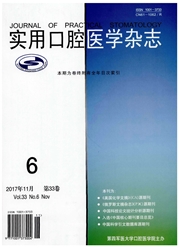

 中文摘要:
中文摘要:
目的:比较人颌骨与长骨来源的2种骨髓间充质干细胞增殖和骨向分化能力。方法:体外组织块培养法和有限稀释法培养颌骨骨髓间充质干细胞(OMMSCs);骨髓穿刺法和密度梯度离心法培养长骨骨髓间充质干细胞(BMMSCs),分别进行流式细胞仪鉴定细胞表面抗原标记;克隆形成、CCK8法以及细胞周期检测细胞增殖能力;骨向诱导后检测ALP活性,茜素红染色检测细胞成骨能力。结果:OMMSCs和BMMSCs均阳性表达STRO-1、CD105,阴性表达CD31、CD34、CD45。OMMSCs和BMMSCs的克隆形成率分别为(24.23±1.13)%和(17.87±1.22)%(P〈0.05);处于增殖(S+G2)期的细胞分别为35.89%和30.41%,OMMSCs增殖速度快于BMMSCs(P〈0.05)。成骨诱导3、5、7、10 d后,OMMSCs ALP活性强于BMMSCs,诱导21 d后茜素红染色显示OMMSCs矿化能力强于BMMSCs。结论:OMMSCs增殖及成骨能力均强于BMMSCs。
 英文摘要:
英文摘要:
Objective: To compare the proliferation and osteogenic differentiation between human bone marrow mesenchymal stem cells from orofacial bone(OMMSCs) and those from long bone (BMMSCs). Methods: OMMSCs were isolated from orthognathic surgical sites and cultured by limited dilution. BMMSCs were obtained from bone marrow of volunteers and isolated by density gradient centrifugation method. The surface markers of the cells were detected by flowcytometry. Single-colony formation, CCK assay and cell circle analyses were conducted. Osteogenic differentiation ability was evaluated by ALP activity test and Alizarin red staining after osteogenic induction culture. Results: The cell surface markers STRO-1 and CD105 of both stem cells were positive, CD34, CD31 and CIM5 were negative. OMMSCs generated significantly higher numbers of colonies than BMMSCs. In addition, OMMSCs had a higher proliferation rate and more ceils in proliferative( S + G2 ) stage than BMMSCs. After osteogenic induction for 3, 5, 7 and l0 d, OMMSCs showed higher levels of ALP activity. OMMSCs formed significantly more mineralized nodules than BMMSCs after 21-day ostogenic induction. Conclusion: The proliferation and osteogenic differentiation capacity of OMMSCs are higher than those of BMMSCs.
 同期刊论文项目
同期刊论文项目
 同项目期刊论文
同项目期刊论文
 期刊信息
期刊信息
